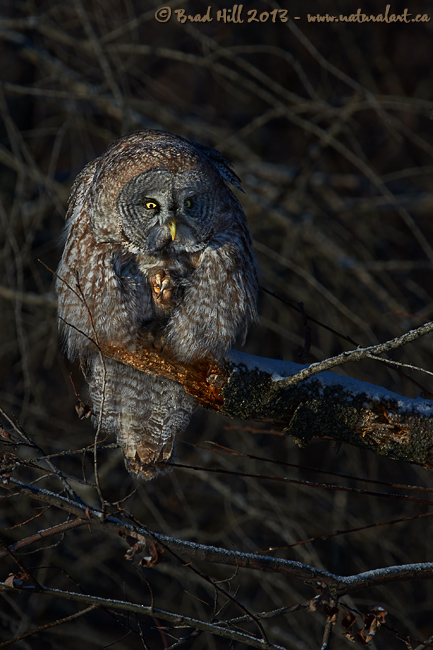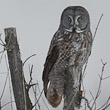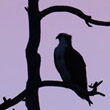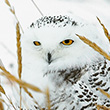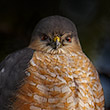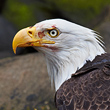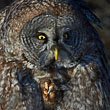Availability: Undetermined - Enquiries?
In the Field
Alien @ Sunrise. Lac du Bonnet region, Manitoba, Canada. March 16, 2013.
I suspect many a mouse would think that this shot accurately captures the "demonly" qualities of this "King of Owls" - the Great Gray Owl. I captured the image at sunrise in mid-March on a terrifically cold morning in southern Manitoba (it was about -25C when this shot was taken). And, for the record, that is NOT an alien emerging from its chest...the owl had JUST finished preening itself as was putting its foot "away" when I snapped this. Nonetheless, I loved the effect that the hunched-over head and the talons combined to illicit...made the owl seem like some evil entity that should be found in some hobbit forest somewhere!
This image - and the circumstances surrounding it - provides at least two areas of interesting discussion. First...I'm often asked why I use pro gear almost exclusively when shooting wildlife. Well...as it so happens, the camera (and lens) I shot this image with (a Nikon D4 and a Nikkor 400mm f2.8 VR lens) got inadvertently left in a vehicle on the night before I shot this. At -25C (or lower). We encountered this owl about one half hour after we had started the vehicles, and when I pulled the camera and lens out of its padded case, they were pretty much frozen solid (note to self - avoid handling a -25C camera with bare hands...it's so cold it hurts!!). But the camera functioned perfectly - I could detect NO noticeable slow-down in AF speed, frame rate, or anything! And the battery performed just fine! Now that's performance! And points to the kind of durability and robustness I LOVE in a camera.
Second...on lens choice. The question I get asked more commonly than anything else is this:
"I'm a Nikon-shooting wildlife photographer, and like so many I own the 200-400mm f4 VR zoom. But now I want the best prime lens for wildlife shooting - should I buy the 400mm f2.8 VR, the 500mm f4 VR, or the 600mm VR?"
OK...there are SO many variables to consider in deciding between these 3 excellent lenses that I can't give ONE answer that will work for everyone. Questions like this - "What do you photograph?", "what's your average working distance?", "are you going to be carrying the lens much or just shooting from a car?", "do you want to hand-hold the lens or will it always be on a tripod?", "what are YOU going to use the images for (and at how large a size)?", and even awkward-to-ask things like "how strong are your arms and back?!" - are all going to factor into what super telephoto is right for you.
But, after using all the lenses in question - and watching scores of clients do the same things on my photo tours - I can say a few things that may help you out.
1. For MANY or MOST, the most critical variable in choosing between these lenses is the WEIGHT of the lens!
OK...users of the 200-400mm f4 lens have it relatively easy in terms of weight - that lens weighs only about 3360 grams (7.7 lb). If you're ALMOST maxed out weight-wise with the 200-400 (i.e, that's about as heavy a lens as you CAN or WANT to hand-hold or even carry around), then you only have ONE option - the 500mm f4 VR (at 3880 grams - or 8.6 lb - it weighs only a LITTLE more than the 200-400). And, overall, the 500mm feels similar to (not identical to - SIMILAR to) the 200-400 in your hands. BUT, at 4620 grams (10.2 lb) the 400mm f2.8 feels a TON heavier (and is way harder to hand-hold). And, at 5060 grams (11.2 lb), the 600mm f4 is heavier again. In fact, when handling the 400mm f2.8 and the 600mm f4 it is easy to confuse them - they BOTH weigh a ton! I can NOT stress too much how important these weight differences can be in real-world use...if you buy the 400mm f2.8 because I (and others) tell you it is uber-sharp, but you end up leaving it at home because it's so damned heavy...well...don't say I didn't warn you!
2. To heck with weight - I want the sharpest and fastest lens...the BEST of the best!
OK...I'm going to call a spade a spade here. After shooting tens of thousands of images with the 400mm f2.8, the 600mm f4, and the 200-400mm f4 VR - and a few thousand images with the 500mm f4 (not mine...and ONLY one copy of it) - here's what I've found: The sharpest is the 400mm f2.8 VR. How does it compare to the 200-400mm when shot at 400mm? At close distances (maybe 25 to 30 meters - or about 70 to 100 feet), noticeably sharper. At longer distances, WAY SHARPER. On distant scenes - as sharp as any lens Nikon makes. Where do the others rank? Second sharpest? The 600mm f4 VR (it's awfully darned sharp). Third? The 500mm f4 VR (pretty darned sharp too!). Fourth? The 200-400mm f4 VR - which is still quite sharp at close range. But here's a critical point - technique plays a HUGE role here. If you're hand-holding these lenses you MAY find that you can get sharper shots with the 200-400mm OR the 500mm than the other two "big guns" simply because you can manage the weight better. And it is also important to know that ALL of these lenses are darned sharp...and the differences in sharpness are often small enough that your ability to effectively sharpen the images in post-processing can MORE than make up for the differences between the lenses!
What about AF speed and performance? Well...of course these variables are impacted upon by camera body in use, but when I have done head-to-head tests on AF speed (and particularly focus-tracking) using pro bodies, I have found that the lenses rank (from fastest to slowest AF) as follows: First - the 400mm f2.8 VR; second - the 600mm f4 VR; third - the 500mm f4 VR; fourth - the 200-400mm f4 VR. It's important to note that the 3 primes were very closely "clustered" in performance, with there being very little real-world difference between them. And all were much faster in focusing (think keeping birds in flight tack sharp for series of images) than the 200-400.
3. What about performance with teleconverters?
Great question. Teleconverters (or TC's) work better with some lenses than others. And the AF system (when the host lens is combined with a TC) will work WAY better on a pro body (especially the D4 and later) than on an "enthusiast" body. And, as focal length of host lens increases the ease of effectively using a TC decreases. Meaning that it's easier to get a sharp image when using a 1.4x TC on a 400mm lens (total focal length of 550mm) than when using it on a 600mm lens (840mm) - simply due to camera shake and DoF concerns.
So that all being said, the 400mm f2.8 VR is one of Nikon's best performers with a TC (either the 1.4x TC-14EII or the 2x TC-20EIII). In fact, when I did head-to-head testing of the 400mm f2.8 VR plus 1.4x TC (550mm) against the 500mm f4 with NO TC (or "native"), I found that the images were sharper - and the AF system faster - with the 400mm f2.8 plus TC than the 500mm f4 shot native. So why on earth would ANYONE buy the 500mm f4 VR. ARRRGGGHHH! Go back to point #1...because it's WAY lighter - and for most users that's the most critical thing!! And, it costs less too.
And one final comment about TC's and these lenses: I have found that the 200-400mm f4 VR works HORRIBLY with TC's - to get decent sharpness you have to stop down to f11 (at least) and the AF is slow and it hunts around a ton. Sorry...I can't recommend using either TC with the 200-400mm f4 VR.
Take home lesson? What do I own? OK...for me the #1 wildlife lens is my 400mm f2.8 VR. Next is the 600mm f4 VR. I use my 400mm (alone or with TC's) about 10x as much as I use my 600mm. And I don't own a 500mm f4 - my needs are definitely covered with the other two lenses. And I sold my 200-400 f4 back in 2012 (and haven't missed it at all).
What should you do? Be honest about your own needs and limitations - and ask those critical questions. What do you photograph? What's YOUR average working distance? Are you going to be carrying the lens much or just shooting from a car? Do you want to hand-hold the lens or will it always be on a tripod? What are YOU going to use the images for - and at how large a size? And, yes...how strong are your arms and back? And the most important point of all, once you fork out the big bucks for your big lens, study its performance and learn how to get the most out of it...
And on a final note: Back to the owl shot...this one was captured with my 400mm f2.8 VR plus the 1.4x TC - and this is about 75% of the full-frame image.
Behind the Camera
Alien @ Sunrise. Lac du Bonnet region, Manitoba, Canada. March 16, 2013.
Digital Capture; Compressed RAW (NEF) 14-bit format; ISO 160.
Nikon D4 paired with Nikkor 400mm f2.8 VRII prime lens plus 1.4x TC-14EII teleconverter (550mm focal length). VR on and in normal mode.
1/640s @ f5; -0.67 stop compensation from matrix-metered exposure setting. Auto ISO engaged with shutter speed set to "Auto" (1/focal length of lens).
At the Computer
Alien @ Sunrise. Lac du Bonnet region, Manitoba, Canada. March 16, 2013.
RAW Conversion to 16-bit TIFF, including first-pass/capture sharpening and light noise reduction using Capture One Pro Version 7. Three raw variants (processed from raw) differing by a total of 1.5 stops in exposure.
Further digital corrections on resulting 16-bit TIFF files using Adobe's Photoshop CS6 and Light Craft's Lightzone. Photoshop adjustments included compositing the raw conversion exposure variants, selective minor tweaks to exposure, and selective sharpening for web output. Final tone tweaking performed using tonemapper/re-light tool in Lightzone.
Conservation
Alien @ Sunrise. Lac du Bonnet region, Manitoba, Canada. March 16, 2013.
Species Status in Canada*: Not at risk.
The Great Gray Owl (Strix nebulosa) is North America's largest (but not heaviest) owl. This rodent-eating specialist and resident of northern boreal foress shows a moderately strong preference for areas nears bogs and especially along forest edges. It is the only member of its genus to breed in both the old and new worlds.
While the Great Gray Owl is not considered to be at risk in Canada, timber harvest - and the subsequent removal of large diameter trees typically used for nesting, roosting, and hunting - can have great impact on their populations. In Manitoba (where this Great Gray was photographed) their preferred habitat may be threatened by forestry, peat extraction, and agriculture.
*as determined by COSEWIC: The Committee on the Status of Endangered Wildlife in Canada













